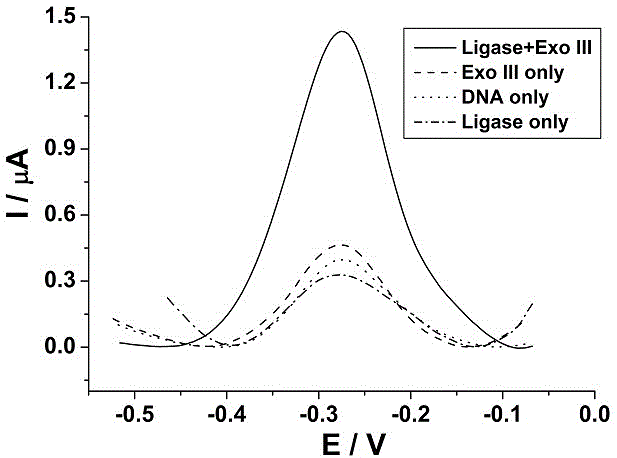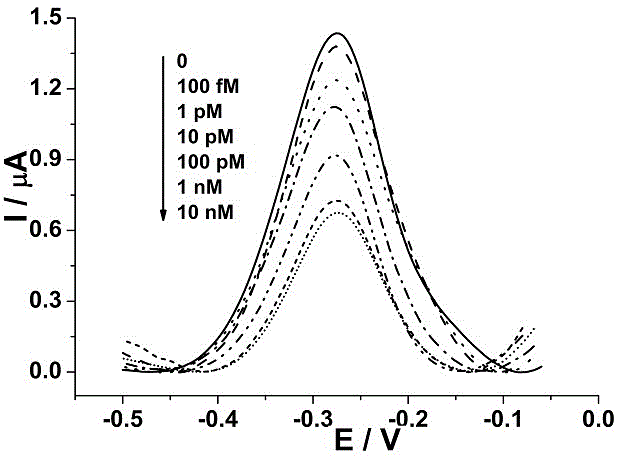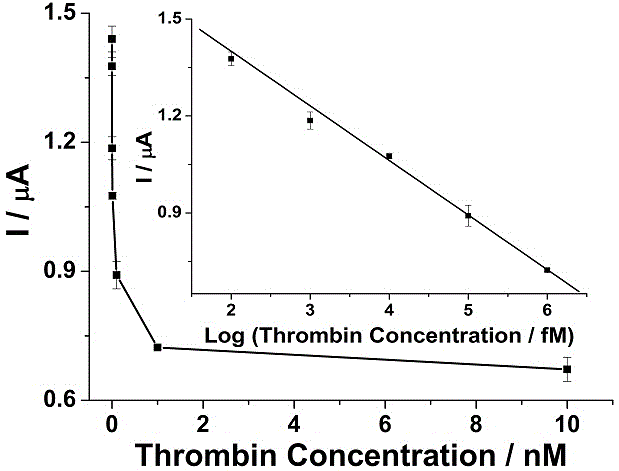Bioelectrochemical sensor for detecting thrombin and its preparation method and application
A technology of bioelectrochemistry and thrombin, applied in the direction of material electrochemical variables, scientific instruments, biological testing, etc., can solve the problems of reducing detection sensitivity, affecting the binding efficiency of aptamer chain and thrombin, and achieving the effect of wide application prospects
- Summary
- Abstract
- Description
- Claims
- Application Information
AI Technical Summary
Problems solved by technology
Method used
Image
Examples
Embodiment 1
[0026] Example 1: Preparation of bioelectrochemical aptasensor for detecting thrombin
[0027] The pyrolytic graphite electrodes were sequentially ground on 800-mesh and 3000-mesh fine corundum sandpaper, and then polished to a mirror surface on silk with a mixture of alumina powder and water with a particle size of 0.05 μm. They were then ultrasonically cleaned in absolute ethanol and ultrapure water for 5 min, rinsed and dry-cleaned with ultrapure water after removal, and dried with nitrogen. Then take 20 μL of 3.5 mg / mL PDDA solution (containing 0.05 M NaCl) to soak the electrode for 20 min, then rinse with ultrapure water and blow dry with nitrogen. Then 40 μL of AuNPs with a diameter of 7 nm was soaked in the electrode for 1 h, then rinsed with water and blown dry with nitrogen. Finally, 40 μL of 1 mMCB[7] was taken to soak the electrode for 60 min, then rinsed with ultrapure water, and then dried with nitrogen, and 20 μL of the mixed solution after the cycle reaction wa...
Embodiment 2
[0030] Embodiment 2: Detection method of bioelectrochemical aptasensor for detecting thrombin
[0031] Add an appropriate amount (about 5mL) of 10mM Tris-HCl (pH7.4) solution into the electrolytic cell, and then pass high-purity nitrogen into it and maintain it for at least 10 minutes; immerse the three-electrode system in the Tris-HCl solution, and continue to maintain a certain Flow rate of nitrogen until the end of the test. Connect the three-electrode system to the electrochemical workstation (model: chi660c; China Shanghai Chenhua Instrument Co., Ltd.), turn on the electrochemical workstation and the test computer, start the control software of the electrochemical workstation, select the detection method as square wave voltammetry, and set The detection parameters are as follows: the potential scanning range is 0~-0.6V, the potential increment is 4mV, the amplitude is 25mV, and the frequency is 15Hz; run the program to start detection, and the corresponding data map will ...
Embodiment 3
[0033] Example 3: Detection of different concentrations of thrombin by bioelectrochemical aptasensor for detection of thrombin
[0034] First, add 5 μL of thrombin solution of different concentrations and 5 μL of 10 nM aptamer DNA chain to 22.5 μL of thrombin binding buffer (10 mM Tris-HCl, 100 mM NaCl, 5 mM KCl, pH7.4), react at 37 ° C for 1 h, and then add 10 nM 5 μL of extended strand, 5 μL of 1 μM probe strand, 10× enzyme reaction buffer (100 mM Bispropane-HCl, 100 mM MgCl 2 , 10mMATP, 10mMDTT, pH 7.0) 5μL and 400unit / μL T4 DNA ligase 0.2μL, mix well, react at 16°C for 0.5h, and then react at 65°C for 10min to inactivate the ligase. Add 0.2 μL of 100 unit / μL ExoIII to the solution, react at 37° C. for 20 minutes, and then react at 70° C. for 20 minutes to inactivate ExoIII. After the reaction, 20 μL of the reacted mixed solution was taken and added dropwise to the surface of the functionalized pyrolytic graphite electrode, incubated at room temperature for 1 h, and then e...
PUM
 Login to View More
Login to View More Abstract
Description
Claims
Application Information
 Login to View More
Login to View More - R&D
- Intellectual Property
- Life Sciences
- Materials
- Tech Scout
- Unparalleled Data Quality
- Higher Quality Content
- 60% Fewer Hallucinations
Browse by: Latest US Patents, China's latest patents, Technical Efficacy Thesaurus, Application Domain, Technology Topic, Popular Technical Reports.
© 2025 PatSnap. All rights reserved.Legal|Privacy policy|Modern Slavery Act Transparency Statement|Sitemap|About US| Contact US: help@patsnap.com



